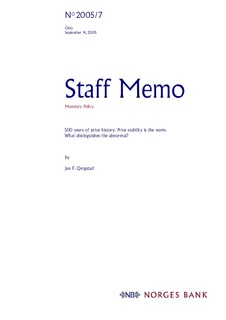| dc.description.abstract | The transition to inflation targeting, which took place in Norway in 2001, may perhaps at the time have appeared to be a transition to a new and unfamiliar monetary policy system. Inflation targeting has, after just a few years, resulted in changes in the way central banks work and not least in the way we communicate with the outside world. But from a long-term perspective, as I have applied today, inflation targeting can be seen more as a logical consequence of what we have learned about monetary policy over several hundred years. But today’s monetary policy system springs from the recognition, based on historical experience, of what monetary policy can in fact achieve. Inflation targeting in this sense is not new, but a way of orienting monetary policy with a view to making the best possible contribution to economic growth. A nominal anchor expressed in terms of an objective of low and stable inflation is a formalisation of what has actually been the norm. Price stability has been the norm if we look beyond our own period of adult awareness and look at long-term historical trends. However, we must also recognise that disturbances have occurred and be prepared that disturbances will continue to occur, as I have shown in my discussion of both inflationary and deflationary periods through history. Such disturbances, whether due to unsuccessful monetary policy, unsuccessful fiscal policy or external conditions over which we have no control will continue to contribute to periods of expansion and periods of contraction in Norway and in other countries. We have been aware of this for a long time. But if we look back, we also see that monetary policy in some cases may have contributed to amplifying these disturbances. The historical knowledge we have now acquired may provide us with greater insight into what inflation actually is, why prices rise or fall and how the monetary policy system should be organised in order to address these disturbances in an optimal way. An important advantage of direct inflation targeting as an objective for monetary policy – in addition to explicitly providing the economy with a nominal anchor – is that the system also gives the central bank and other economic agents a clear guide as to how monetary policy shall and should be oriented when disturbances occur. Again, insight into our own history has been an important starting-point. | nb_NO |

